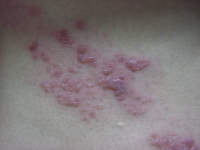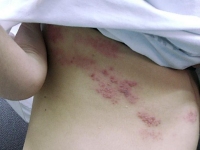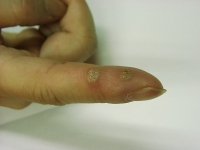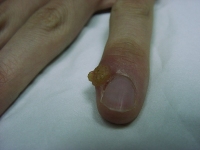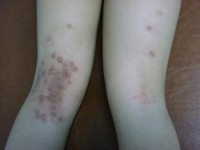Herpes Simplex
There are two types of herpes simplex viruses (HSV), I and II. Type I usually affects the mouth inside, the lips, and the areas around. That on the lips is common known as cold sores. The transmission is by simple kissing or using shared towels. Type II usually affects the genital areas and is transmitted by sexual contact.
Signs
During the initial infection, there are tiny, clear fluid-filled blisters in the areas affected. It is itchy and painful. The blisters later crust and the skin heals without scarring.
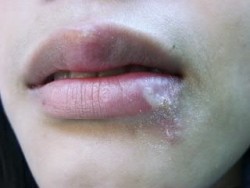
However, the viruses are not eradicated. They will enter the nerve cells and remain in a dormant phase. When the host is in a lower immune status, they are un-checked, and will become active again with the vesicles reappearing in the same site or nearby. There is usually a tingling sensation in that area in the early stage of recurrence.
Diagnosis
Typical history and appearance makes the diagnosis easy. If the diagnosis is not certain, particularly when it happens in the genital areas, when a definitive answer may be requested, then laboratory test such as specific antibody tests, smear and tissue culture may be done.
Management & Treatments
Do not share towels and come into close intimate body contact with someone else, as it is contagious when the disease is active. For simple cold sores, acyclovir cream can shorten the period and speed as recovery. It is best if it can be applied during the “prodrome”, in which case the blisters may be prevented from appearing completely.
For more widespread infection or those in the genital areas, oral treatment is necessary. Acyclovir is a standard regime but it needs to be taken 5 times per day because of poor absorption. Newer generation such as valacyclovir or famciclovir has better absorption and can be taken 2 or 3 times per day, but they are a lot more expensive. The usual period of treatment is 5 to 7 days.
Since the medication cannot penetrate into the nervous system, they can only kill the viruses that are outside. The viruses unaffected will mount another attack when the immune activity of the host is low. If the recurrences are very frequent, then it is reasonable to take a course of lower dose over a period of 3 months.
Herpes Zoster
This is caused by the Varicella Zoster Virus (VZV). It appears as chicken pox when the person is first infected with it. Chicken pox is a very common childhood infection, and almost every one of us has been infected. Although we are immune from repeated infection after the resolution of chickenpox, VZV lies dormant in the nervous system in the spinal cord.
The VZV is usually under inhibition by our immune system. When the immunity is low, it will be reactivated, travels from the spinal cord to the skin surface via 1 or 2 particular nerves, and results in rash with blisters. This is herpes zoster.
A person of any age with a prior chicken pox may develop zoster, but incidence increases with advancing age due to declining immunity. Any factors that may lower the immune activity may also cause the reactivation, such as over tiredness, time of a cold or other illnesses, taking some medications such as steroid or other immuno-suppressants.
Signs & Symptoms
Our nerves are divided into either left or right side, and each nerve supplies an area we call a dermatome. Therefore the viruses will travel through the nerves to the related dermatomes on one side only.
|
|
|
The most commonly affected areas are the chest (T4, T5), the waist (T10, T11), and the upper face (V1). However, it can happen in any areas, but is generally limited to 1 dermatome or at most 2 or 3 adjacent dermatomes in normal hosts.
|
|
|
While the viruses are traveling in the nerves before reaching the skin, the inflammation of the nerve (neuritis) will result in some altered sensations in the related dermatomes. These include itch, tingling, ache and pain. It can be mistaken as a muscle sprain in the waist, or in some cases even a heart attack when it happens on the chest.
Then in the next few days, a rash appears, initially like urticaria, but very quickly painful blisters develop in the rash. Most patients describe the pain as burning, throbbing, or stabbing. The blisters slowly dry up and crust over 7 - 10 days. The whole recovery takes up to 2 - 3 weeks.
Diagnosis
It is based primarily on the history of prodromal pain, and the characteristic location and appearance of the skin eruption. In some patients, the presentation can be atypical and may require additional testing such as smear and DNA tests.
Complications
It usually has a benign course, but complications may occur. There may be superimposed infection from other bacteria, as the host’s immunity is already lowered.
The pain in the dermatome may continue even when the rash has apparently resolved. This is called post-herpetic neuralgia, and is more common in patients more than 50 years old. The pain usually resolves within 6 months, but more than 1% of patients continue to have pain for a long time, and it can be excruciating.
When it affects the upper face, it may be associated with inflammation of the cornea, which may ulcerate and lead to blindness.

Less common complications are involvement of cranial nerves and the brain, which can be very delibitating.
Managements & Treatments
Although herpes zoster usually resolves in 2 to 3 weeks, but it is important to shorten the duration for pain, as well as to reduce the chance of complications.
The usual treatment is with high doses of acyclovir, 800mg taken 5 times per day, for 1 to 2 weeks. The newer generations, valacyclovir and famciclovir, have better bio-availability, can be taken only 2 - 3 times per day, and apparently are more effective. For those people with widespread disease because of poor immunity, treatment with intravenous acyclovir may be required.
The pain can be managed by simple paracetamol, but stronger analgesics would be need for more severe pain. If there is co-existing bacterial infection, topical or oral antibiotics are needed.
It the herpes zoster involves the area on the nose tip, or around the eye, the cornea may be affected and it requires the examination by an opthalmologist.The addition of oral steroid has no effect on the development or duration of post-herpetic neuralgia. Carbamazepine and amitriptyline are sometimes used to treat post-herpetic neuralgia. Severe cases may require the help of an anaethetist, who will need to cut the nerve involved to relieve pain.
As the current medications cannot penetrate into the nervous system and kill all the viruses, herpes zoster may happen again in subsequent years, but may in a different area.
Warts
Warts are cause by the infection of the superficial skin layer with the Human Papilloma Viruses (HPV), through direct contact of the skin.
Because of our natural immune defense mechanisms, warts may sometimes regress and leave no trace. It may take from a few weeks to a few years. However, immunity to one sub-type of HPV does not offer protection to infection from another sub-type.
Common Warts
They usually happen on the hands and fingers. Each is a discrete, round lump of skin colour. The surface is rough and irregular, and the skin may be thick and hardened. There may be 1 single, or multiple lumps. Sometimes a few of them may join together as a large piece.
|
|
|
If the surface is scrapped with a sharp knife, there appear some bleeding points, which are the blood vessels that grow into the wart.
People who come into contact with raw meat, fish, or shellfish are in particularly high risk of contracting this infection. Very often there may be over 10 of these in one hand.

Planter Warts
They grow in any part of the sole. Because of the pressure from standing, the warts are often pushed inwards. Each is discrete and round, with some hardened white skin in the rim. When many of them coalesce together, it becomes a large piece called mosaic wart.
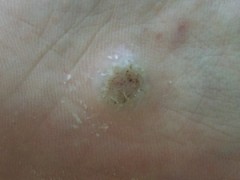
The blood vessels inside the wart are often clotted (thrombosed) and hardened, and appear as some black dots. This is an important sign that differentiate wart from corn, which is merely a hardened skin because of chronic friction.
Plantar warts can be very painful, due to the hardened skin. It is like having a small stone inside the shoe while walking. Sometimes the pain is due to the thrombosed blood vessels.
Plane Warts
These usually appear on the face or the back of hands, as tiny, flat and slightly raised lumps, with brown or skin colour. With time they will spread slowly, become numerous and more noticeable.
Genital Warts
This is in general regarded as a sexually transmitted disease, through direct sexual contact. Occasionally it may due to the transfer of viruses from a wart elsewhere on the body. They appear as round or flat lumps on the surface, sometimes inside the vagina.
Genital warts caused by some sub-types are highly related to the occurrence of skin cancer on the penis, and cervical cancer.
Management & Treatments
Since there is no medication that can be used to kill the viruses, the usual treatment regime involves direct destruction or removal of the infected tissue. The immune modulators offer a new potential in treatment.
Destruction Methods
1. Wart PaintsThey are simply corrosive liquids, or pastes, that chemically burn the tissue away. This is a blind treatment as the amount of tissue burn is not predictable.
They have a fair chance of success when treating common warts on the hands, because these are usually more superficial. The plantar warts are usually pushed deeper into the skin and the success rate is rather low, and very often they make the skin around the wart soft and soggy, which actually promotes the spread of the wart further.
They should not be applied on the face because of the possibility of scarring.
2. CryotherapyThis involves spraying of very cold liquid nitrogen onto the wart, freezing the skin tissue, so much so that it will eventually drop off. Again this is a blind guess treatment without knowing how deep the freezing temperature has reached. Because of this, it is more effective in treating warts other than plantar warts.
To ensure the freezing go deep enough in the plantar warts, it needs to be applied for a long enough time, and this can be quite painful, which is difficult to achieve without the use of local anaesthetics. This explains the very low success rate when doctors try to treat the plantar warts with cryotherapy, while just asking the patient to withstand the maximal pain they can tolerate.
Overall the success rate is only moderate, with around 60% success after applying 3 - 4 treatments at 2 - 3 weeks intervals.
3. Cauterisation & CO2 LaserThis aims to burn the infected tissue away by using heat. This is achieved by using a cautery or CO2 laser. The wound is left to heal. Usually a bigger margin is burn away too, to remove maximally any tissue still infected with the virus, and minimise the chance of recurrence.
|
|
|
|
Before & Immediately After CO2 Laser |
|
This needs to be done under local anaesthetic. The wound can be examined as the tissue is burn away, and this results in a more accurate guess of whether enough tissue has been removed. For plantar warts, the success rate is high at around 70 – 85%, after one single treatment. For more superficial warts on the hands (except those very close to the nail), face and genital areas, the success rate is close to 100%.
4. Surgical RemovalIf the wart is small, and the area infected can be safely excised, then it can be entirely cut off and the skin sutured. It is 100% effective for small superficial non-plantar warts. It is seldom necessary these days because cauterisation and CO2 laser already offer an effective treatment.
Immune Modulators
1. Imiquimol CreamIt is used mainly for genital warts, although there are evidences that it can be effective in other types too.
It works from within by activating the body's own immune system. When it is applied to the skin, immune cells are activated and travel to the area to eliminate cells that have been infected with the human papilloma virus.
This is applied 3 times per week. The warts should be seen to regress slowly. Overall the success rate is around 60 - 75%.
2. InterferonsThere are quite a few different interferons, alpha, beta, and gamma. They can kill viruses and prevent them from reproducing, as well as stimulate the immune system to fight viruses. It is not the first choice, but may be used when other treatments have failed, or when the numbers of warts are just too many to treat individually. It cannot be used during pregnancy because of harmful effects to the baby.
Previously it is injected into the arm or buttock to achieve an overall systemic effect. Now it can be injected into the base of a wart. The efficacy ranges from 50 - 70%.
Side effects are flu-like symptoms such as fever and chills, muscle aches and pain at the injection site.
Molluscum Contagiosa
It is an infection of the skin by a poxvirus. It is common in children and spreads by direct body contact among schoolmates or siblings. It can occur anywhere on the body, but is frequently seen on the face, limbs, and hands.
Sometimes it is spread through contact with contaminated objects such as towels, or toys. It can also spread through sexual contact where the lesions happen in the genitalia.
Signs
It appears as a small, pearl colour, dome-shaped lump, filled with some fluid. It often has a dimple in the centre, with a central plug of white, cheesy material. They may occur in lines when the patient has scratched the lesion and spread the infection along the scratch line. Very often they appear as a corp.
|
|
|
The typical size is about 2 - 5 mm in diameter. There is usually no inflammation unless it has been scratched or irritated.
Management & Treatments
For people with normal immunity, they often disappear on their own after a few months to 2 years. Therefore no treatment may be required, but during this period topical treatment such as calamine lotion may be used to reduce the itch and prevent spread through scratching. Close body contact should be avoided to minimise spread to other people.
If necessary the lesions can be treated individually by cryotherapy, cautery or CO2 laser.




